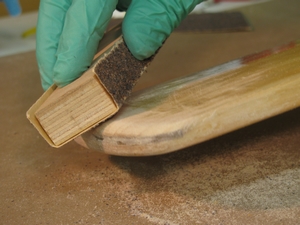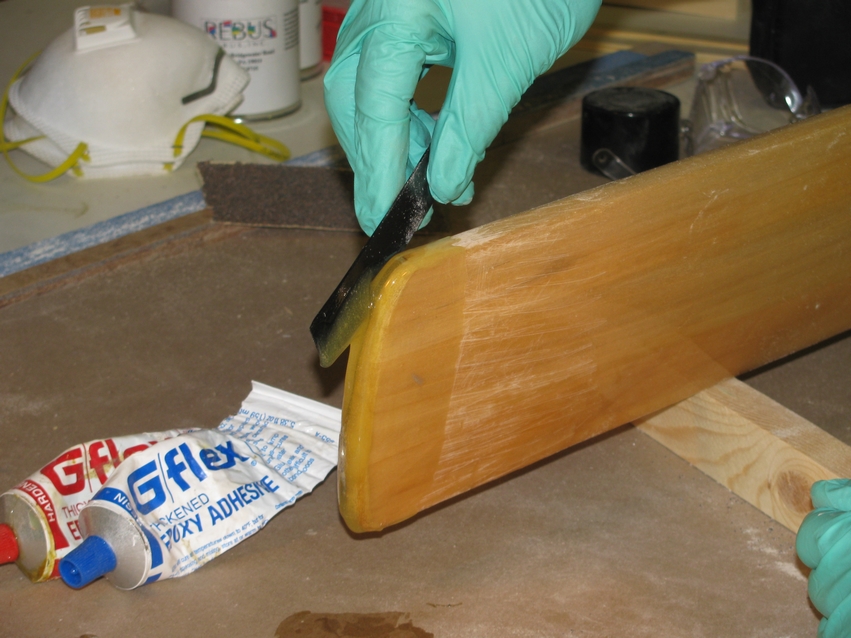
By Tom Pawlak — Retired GBI Technical Advisor
Wooden paddles and boat oars are known for getting dented in service. While G/flex 650 is not optimized for use as a coating, we found it was worth the extra effort it takes to apply to wooden canoe paddles and boat oars to deflect impact and prevent cracking the wood beneath.
G/flex epoxies weren’t developed with coating in mind, but early on in applications testing, we discovered they were excellent at dealing with impact. This became evident when we used G/flex 650 (the unthickened version) as a coating and when we used G/flex 655 (the thickened version) as a protective buildup.
Compared to the cracking that normally occurs with production-made wooden paddles and oars when the blade is dented, a coating of G/flex can offer a huge benefit.
Every pair of wooden oars I’ve ever purchased has had the clear sealer finish peel off wherever they were slightly damaged. When the coating is damaged due to abrasion or impact, water gets into the surrounding wood and the coating peels off soon after. This is probably because the wood swells and the coating can’t stretch enough to stay attached.
As a base coat, G/flex handles minor impact without cracking. The wood does not swell, which means the protective paint or varnish layer applied over it stays nice looking. It will require less maintenance over time. If the coating is breached due to a more severe impact and water does get in, G/flex can stretch enough to stay attached and is less prone to peeling off.
G/flex 655 handles impact remarkably well when it is applied to the tips of wooden paddles and oars. We repeatedly struck a cured bead of it with a 1/4” diameter steel rod. The epoxy didn’t crack or chip. The oar tip you see in the photo was used as a demonstration piece at several boat shows this past spring and summer. We struck it dozens of times with the steel rod. Visitors to our booth would cringe in expectation of damage to the paddle tip, but no damage occurred.
How to use G/flex 650 as a sealer under varnish or paint

1. Remove all old paint, varnish or sealers to expose fresh wood on the end of the paddle.
2. Brush on a coat of G/flex 650 with a stiff bristled brush. For an ideally stiff brush, trim bristle length by half.
3. Apply a seal coat of G/flex epoxy beginning with any end grain, moving on to face grain and edge grain. Finish by applying a second coat to the end grain.
4. Apply a second coat, if desired, while the first coat is tacky like flypaper. If the initial coat is already cured, clean it with water and abrade it with an abrasive pad or sandpaper before recoating.

5. If you plan to paint or varnish, first allow the G/flex epoxy to cure overnight or longer, then wash with water and sand dull.
6. Apply the paint or varnish of your choice. An excellent varnish over any epoxy is Captain’s Varnish #1015.
How to improve the toughness of wooden paddle and oar tips with G/flex 655
1. Remove all existing finishes on the tip of the wooden paddle or oar.
2. Sand a 45° bevel on the end of the paddle or oar blade, front and back, with a hard sanding block and coarse sandpaper.
3. Mix a batch of G/flex 655 on a flat surface.
4. Apply the epoxy to the tip of the paddle from both sides, one side at a time.
5. Invert the paddle blade and clamp while curing so the epoxy does not slump during cure.
6. Wash the tip with water and touch up with a sanding block. Apply another layer of G/flex if necessary to achieve a smooth, uniform buildup.
7. Give it a day to cure at 70°F or above (or a bit longer at cooler temperatures) before using the paddle.
Test the blade tip for toughness in the shop by striking it with the shank of a large screwdriver, but I think you’ll agree it is much better to do this sort of testing on the water while paddling over a rocky, clear-water stream.







